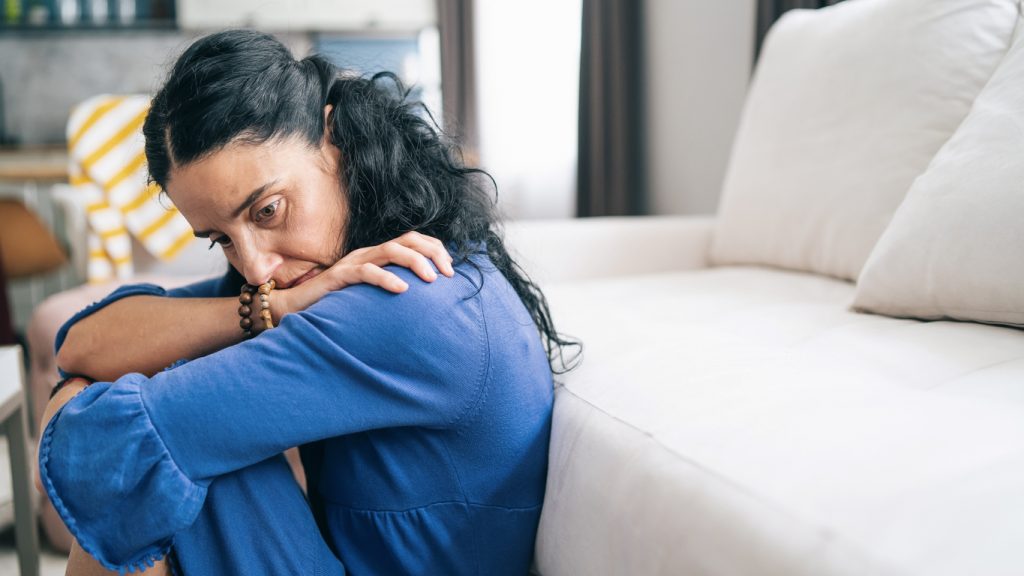Depression in Australia: Facts, symptoms and how to get help
With one in six Australians currently experiencing a mental health condition, it’s likely you know someone who has depression or anxiety (or both) – or have experienced symptoms yourself.
What is depression?
While symptoms of depression and anxiety often go hand in hand, they are, in fact, distinct disorders. Depression is a serious medical illness that negatively impacts your mood – how you feel, the way you think, how you act.
While many of us feel sad or low from time to time, depression causes a persistent and intense feeling of sadness and a loss of interest, and can lead to a variety of physical and emotional issues for extended periods of time, sometimes without any apparent reason. While it’s essentially one condition, the symptoms of depression can feel very different to different people.
Many people mistakenly believe that being depressed is a choice, and that those with symptoms can suddenly decide to stop being depressed. This is not the case.

Depression and anxiety
Anxiety disorders, on the other hand, cover a spectrum of conditions, most characterised by thoughts of worry. Generalised anxiety disorder (GAD) is the most common condition, but anxiety also includes phobias, panic disorders, adjustment disorder and stress.
Symptoms of depression
Being unhappy isn’t the same as being depressed – depression is ongoing, and can often last for weeks, months or years. While symptoms (and their intensity) vary between people, they can include changes to your:
- Behaviour: You don’t go out, rely on alcohol or sedatives, withdraw from family/friends, are unable to concentrate and get things done.
- Feelings: You are miserable, sad, frustrated, overwhelmed, guilty and lacking in confidence.
- Thoughts: You feel like a failure and worthlessness, and like life is not worth living.
Depression can also have physical symptoms, including weight loss or gain, headaches, persistent tiredness, sleep problems, aches and pains, and illness.
Signs of depression in men
Statistics show that over a lifetime, one in eight Aussie men will experience depression. They are far less likely to seek help for mental health conditions than women, leading to much higher suicide rates. Men are also three times more likely to die by suicide than women.
Men are more likely to try to mask symptoms of depression by drinking heavily or turning to drugs, prior to the onset of depression. They’re also more likely to distract themselves from their feelings by turning to other outlets: perhaps working excessively or engaging in risky behaviours. Anger and irritability are also common signs of depression in men.
Signs of depression in women
Women are more likely to experience depression than men, with one in seven women reporting depressive symptoms over their lifetime. There are a number of reasons for this, some biological, some societal.
When depressed, women tend to dwell on negative feelings – this rumination may manifest as negative self-talk, crying for no obvious reason and self-blame. Women are also more likely than men to become depressed after a stressful life situation, such as a break-up or death in the family, and often this leads to eating disorders.

Causes of depression
There’s no single cause of depression – it can occur for many reasons, and can have different triggers, including:
- Stressful life events: Death, relationship break down, job loss, abusive relationship, ongoing work stress
- Loneliness
- Serious medical illness
- Abuse of alcohol and drugs. More than 500,000 Australians will experience depression and a substance use disorder at the same time, at some point in their lives
- Personality: Some people – particularly if they have a tendency to worry a lot, have low self-esteem, are perfectionists, are sensitive to personal criticism, or are self-critical and negative – may be more at risk of depression because of their personality
- Gender: Women are more likely than men to become depressed. Although there’s no conclusive evidence why, many believe it’s related to hormonal changes that women go through at different stages of their lives, including during and after pregnancy
- Age: Rates of depression tend to be particularly high among youth – more than 75% of mental health problems occur before the age of 25 – and elderly populations of Australians, according to Beyond Blue.
Is depression hereditary?
Some people are at an increased genetic risk of suffering from depression – if someone in your family has depression, you’re more likely to as well. But this doesn’t mean you definitely will. Physical, emotional and environmental factors can also play a major role in the onset of depression, which means that you can have depression even if no one else in your family does.
Types of depression
There was a time when all mental health disorders were lumped together as one. Today, your doctor will make a diagnosis based on the particular disorder or subtype of depression that you exhibit. These include:
Major depressive disorder: People with major depressive disorder experience symptoms most of the day, every day, for an extended period of time. The disorder is sometimes referred to as major depression, clinical depression, unipolar depression or depression. There are three main types:
1. Melancholic depression: This is a severe form of depression that results in a number of physical symptoms being present. A depressed mood is characterised by complete loss of pleasure in almost everything.
2. Psychotic depression: This form of depression involves losing touch with reality and experiencing psychosis, including hallucinations, delusions and paranoia.
3: Postnatal, prenatal, perinatal depression: Women are at an increased risk of depression during pregnancy (prenatal) and following childbirth (postnatal). Some doctors also reference perinatal depression, which covers the pregnancy period as well as the first year after the baby’s birth. While 80% of women experience hormonal changes and stress during and after pregnancy, this does not always lead to depression – around 10% of women experience prenatal depression, while 16% report symptoms in the first three months after having a baby.
4. Bipolar disorder: Bipolar disorder sees you experience periods of depression and periods of mania – almost the opposite of depression – with periods of normal mood in between. Often, you lose touch with reality and have episodes of psychosis. It’s not a fleeting experience, and it affects around 3% of Australians.
5. Cyclothymic disorder: This is somewhat like bipolar disorder, where you experience fluctuating moods over an extended period of time, but with milder symptoms and longer stretches of normal mood between manic and depressed moods.
6. Dysthymic disorder: Dysthymic symptoms are similar to major depressive disorder, but less severe – they do, however, last for a longer period of time.
7. Seasonal affective disorder (SAD): This mood disorder has a seasonal pattern, thought to be related to a variation in light exposure. Depression that begins in winter and subsides when the season ends is the most common form of SAD, and is more prevalent in parts of the world that experience long periods of darkness over winter months.

How is depression diagnosed?
Depression rarely goes away by itself and can get worse without treatment. So, it’s important to reach out to a doctor when you notice symptoms.
While doctors will likely perform physical exams and lab tests, the most helpful diagnostic tool a doctor has is conversation.
Depression test
To adequately diagnose your type of depression, your doctor needs to hear about your specific symptoms. They may talk through a series of standard questions with you, or ask you to complete a questionnaire reporting on things like your daily moods, behaviours and lifestyle habits.
Treatments for depression
There’s no single way that people recover from depression – it’s different for everyone. But there are some treatments that are particularly effective and are commonly used by doctors.
If you are experiencing symptoms, you should speak to a doctor to find out the right treatment for you. You can request a telehealth consultation with one of our Australian-registered doctors from anywhere in Australia, seven days a week.
Psychological treatments are designed to help you identify certain behaviours, change the way you think and improve your coping skills, so you’re better equipped to deal with life’s stresses and conflicts. These ‘talking sessions’ include cognitive behavioural therapy, interpersonal therapy, behavioural therapy and mindfulness cognitive therapy. They might be one-on-one sessions with your doctor, or could be offered in a group environment – some are also available online.
You can also try these 10 simple strategies to reduce anxiety and depression.

How to help someone with depression
While there’s no definitive rulebook when it comes to helping someone with depression, there are a range of strategies you can consider when reaching out. The first step is learning about depression, to give you a better understanding of what those suffering from the disorder are going through. Then:
- Help them find support: It can be daunting to take this first step and having support and guidance can be invaluable.
- Offer ongoing support during therapy: There are some days when getting out of bed to see a doctor seems impossible. Be there to encourage and offer a helping hand.
- Assist with day-to-day activities: Sometimes, simple everyday activities can be overwhelming for those suffering from depression. Your support might include helping shop for healthy groceries, picking up kids or doing the dishes.
- Be patient: Recovering from depression can take a long time, with many highs and lows along the way.
- Stay in touch: Make sure you reach out on a regular basis, to check in or for an extended chat.
What to say to someone with depression
A fundamental way to support someone with depression is to start a conversation. Let your friend know you’re there for them. Be aware that they may want to talk about their situation and feelings, but they may not want advice. Try asking open questions like:
- It seems like you’ve been having a hard time lately. What’s on your mind?
- The last few times we hung out, you seemed a little down. Is there anything going on you that you’d like to talk about?
- You mentioned going through some hard times recently; how are you feeling about everything?
- What are you in the mood for right now?
Validate their feelings and show empathy and interest with your body language.
Avoid being judgmental or dismissive through questions and statements like:
- Don’t you see how lucky you are?
- Why are you making such a big deal about this small thing?
- What’s the matter with you?
- I’ve totally been through the same thing.
- Things could be worse.
- What do you have to be depressed about?
For more information, visit Beyond Blue. If you are experiencing symptoms, you should speak to a doctor to find out the right treatment for you. You can request a telehealth consultation with one of our Australian-registered doctors from anywhere in Australia, seven days a week.
To speak with an InstantScripts Doctor:
Request a ConsultationIf you have run out of your script:
Request a ScriptThis article was authored by Natasha Dragun who has been writing about health and wellness for more than 20 years. It was written in conjunction with the InstantScripts Australian medical team.
© InstantScripts
Level 8 / 637 Flinders St.,
Docklands VIC 3008

